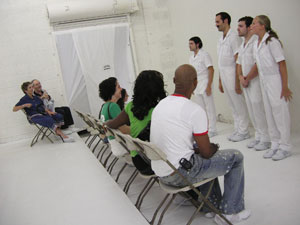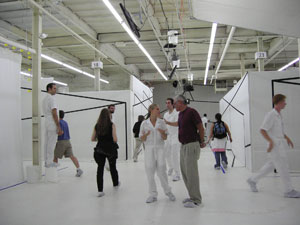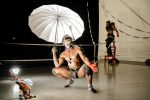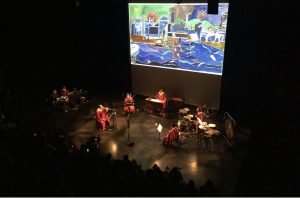The average working artist or creative professional probably wishes she had a dime for every time a client told her “We’ll send your payment at the end of this week, or early next,” and another dime when the money still failed to materialize by Monday.
As an artist, it’s easy to feel powerless. But every year, when I cover the Philadelphia Fringe Festival, I’m fascinated to see that dynamic turned on its head. Somehow, something in us longs to pay for a chance to have the artists boss us around.
Eleven months out of the year, I put my butt in the chair, open the playbill, wait for the lights to dim, and know the actors are going to stay where they belong: onstage for my entertainment. I don’t need to do anything but turn off my phone, watch, listen and applaud at the end. But when I embark on the Fringe Festival, I never know what I’m going to have to do.
A chronicle of artists taking charge at the Fringe
In 2005, the actors demanded that I put on plastic booties before watching the show while another performer tried to feed everyone yogurt and made an audience member come onstage to brush her hair. Later, I had to climb into someone’s dark basement to watch a Beckett monologue. 2008, I handed my ticket over and was ushered onto a packed, roasting-hot school bus that shuttled the audience to FDR skate park, where we sat down on the concrete to watch a version of “Oedipus”. Last year, a completely naked performer at the Suzanne Roberts Theater took about fifteen minutes to mock members of the audience (including me) with an exquisite series of obscene sexual mimes. On another night, I traveled to a performer’s own home, watched the show in her living room, and then sat down to a pot-luck dinner we ticket buyers had been required to provide.

This year, I got a ticket to “The Quiet Volume” at the Free Library, which was not a show so much as the artists whispering to me through my iPod earbuds for one hour, directing to me open and close books, read the passages they’d chosen, and perform a subtle duet of hands with the stranger sitting next to me.
Pig Iron set the bar high with Pay Up
But for artists ready to take you in hand, it’s hard to beat Pig Iron, who first made me put the booties on in 2005. They re-mounted “Pay Up” this year, and it was one of September’s hottest tickets. Seemingly bolstered by their previous success in bossing the audience, their orders began before you even left home, in the form of a mass e-mail. They said we should take the train, not drive. They said we shouldn’t bring a heavy bag (when I brought a very light backpack this year, they confiscated it anyway). They mandated sensible shoes and warned us that we could not be late. And most commanding of all, they said to bring a few dollars along, because the price you paid for the ticket wouldn’t be enough to get you through the whole show.

“Pay Up” is a site-specific piece that unleashes the audience in a large room full of small partitioned rooms, and then lets attendees choose which mini-performances to attend, each costing a dollar or two at the door (everyone in booties, of course). The cast and the script give instructions to the audience, who scramble to catch the vignettes in the time allotted.
Did I mention that the actors made me climb up and down several flights of stairs and write two Haikus before I was allowed to see the show?

Turning the tables gives hope to all artists
In short, as soon as the Fringe begins, I know the tables are about to turn. Theater which stays on the stage for most of the year is about to get interactive, but it’s more than that. Instead of us presiding over the artists, they’re going to preside over us.
If you peruse the Fringe catalogue or chat with a Fringe artist after the show, lots of them talk about “upending the conventions of the theater.”
But often, what they’re really talking about is a shift in the usual balance of power. There are many reasons to love the Fringe Festival, but as a creative professional, this one may be my favorite. Making my own living as a writer can be quite a grind, but when thousands of ticket buyers pay a good price to watch the creative types get uppity for once, I can’t help but wonder if it’s a ray of hope for starving artists everywhere.
The 2013 Philadelphia Fringe Festival ran from September 5-22 and featured over 150 different shows in venues around the city.
You can read more Alaina Mabaso essays at her website, and follow her on Twitter @AlainaMabaso.









